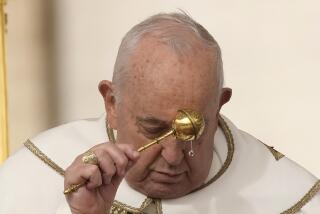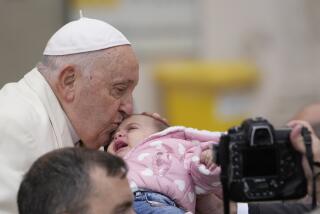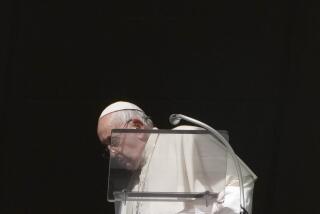Pope’s Visit to Mt. Sinai Fulfills Longtime Goal
ST. CATHERINE'S, Egypt — On a pilgrimage he had awaited for two decades, Pope John Paul II knelt Saturday by the mountain where the Ten Commandments are believed to have come down to Moses and prayed for the most elusive dream of his papacy--a closer rapport among religions that worship one God.
“Today, with great joy and deep emotion, the bishop of Rome is a pilgrim to Mt. Sinai, drawn by this holy mountain which rises like a soaring monument to what God has revealed here,” he told about 500 of the faithful who followed him here. He said the commandments offer “the only true basis for the lives of individuals, societies and nations.”
It was a moment of personal fulfillment for history’s most-traveled religious leader, an ailing 79-year-old missionary on the first leg of a valedictory tour--one that is scheduled to take him to Jesus’ birthplace and other biblical sites in Israel and the Palestinian territories next month.
John Paul first spoke five years ago of his desire to pray with Jewish and Muslim leaders here in a turn-of-the-millennium summit of the three monotheistic faiths. At the time, he declared his ambition to heal a 1,000-year schism between Orthodox Christians and the Roman Catholic Church.
But on Saturday at St. Catherine’s, a desert monastery on the spot where God is said to have revealed himself to Moses in the form of a burning bush, John Paul sank to his knees and prayed in solitude.
Afterward, Greek Orthodox Archbishop Damianos, whose church runs the 6th century monastery, lectured his guest that “complete union of Christians” can be achieved only if Catholics avoid “every form of proselytism, coercion or prejudice.”
“We are near but not together,” the archbishop told reporters later, echoing a disappointing refrain John Paul has heard from Orthodox leaders throughout Eastern Europe, the Balkans and the Middle East. Damianos added that unity “is possible, but it would take a miracle.”
Greek Orthodox leaders showered the pope with gifts, including icons depicting Moses and St. Catherine, a 4th century martyr, but did not take part in his liturgical service for seven busloads of Egyptian Catholics in the monastery’s olive grove.
Refusing to surrender his ecumenical dream, John Paul asked the pilgrims to join him in praying that in the new millennium the monastery will become “a radiant beacon calling the churches to know one another better.”
The pontiff spoke beneath a flowering almond tree on a terrace overlooking the grove where, Christians and Jews believe, the Israelites waited while Moses ascended Mt. Sinai to receive the Ten Commandments more than a millennium before Christ. Moses, in the biblical account, was leading his people out of slavery in Egypt on a mission God had given him earlier at the burning bush.
John Paul has been called a modern Moses because, from the day of his election in October 1978, he was convinced that God had chosen him to lead his billion-member flock into the next millennium. Prompted by a mystical attachment to what he calls the history of salvation, he vowed to celebrate 2000 with a pilgrimage to biblical sites.
In recent years, his tremors and other symptoms of Parkinson’s disease have worsened, raising doubts about his ambitious itinerary. But on Saturday he spoke clearly and looked unusually steady, apparently drawing strength from a holy site that, in his words, “prompts us to cry out in overflowing joy.”
Worshipers in the grove tore off olive branches and waved them in salute, and John Paul replied with a jaunty wave of his cane. In the Chapel of the Burning Bush, he grasped the altar to kneel without assistance and stood up on his own after 10 minutes of silent prayer.
Secular and religious politics, more than ill health, have limited his biblical itinerary.
Prolonged talks with Iraq’s government broke down before Christmas, forcing the pope to renounce a pilgrimage to Ur, the ancient city believed to be the birthplace of Abraham, who is revered by all three monotheistic faiths.
Instead, the pope turned his general audience at the Vatican on Wednesday into an unusual “virtual pilgrimage” featuring oak branches, flaming copper pots, a 15th century icon of an angel visiting Abraham, and a film showing Ur and the surrounding desert.
Saturday’s pilgrimage to Egypt’s Sinai Peninsula was the real thing. Egyptian soldiers lined his motorcade route to the mile-high seminary at the foot of Mt. Sinai, and Polish pilgrims shouted greetings in the parking lot. Twenty-two Greek Orthodox monks took him inside for a tour of ancient relics, including bones touted as St. Catherine’s.
In a peculiar ritual, the pope took off his ring, touched it to a finger bone and the skull of the Egyptian saint, then kissed it and put it back on his finger.
His sermon at the liturgical service, though shunned by non-Catholics, was about the universal value of the Ten Commandments. These, he said, “are not an arbitrary imposition of a tyrannical Lord. They were written in stone; but before that, they were written on the human heart as the universal moral law, valid in every time and place.
“The wind which still today blows from Sinai,” he added wistfully, “carries an insistent invitation to dialogue between the followers of the great monotheistic religions in their service of the human family. It suggests that in God we can find the point of our encounter.”
Damianos, the Greek Orthodox archbishop, told reporters that John Paul’s idea to pray here with Jewish and Muslim leaders never got far. Mohammed Sayed Tantawi, Egypt’s leading Sunni Muslim cleric, was sharply criticized at home a few years ago for receiving Jewish leaders.
“Inter-religious prayer as a celebration is impossible” at that level, especially in Arab countries, Damianos said.
John Paul, however, met with Tantawi in Cairo on Thursday, drawing no criticism from Egyptians, and is scheduled to call on senior rabbis in Israel next month. The pope and Tantawi, who agreed to make his first visit to the Vatican later this year, advanced a dialogue begun two decades ago between theologians from the Vatican and Egypt’s Al Azhar University, both sides said.
“It was never in our minds that we could have the three religions praying together today,” said Makarios Tewfik, the Catholic bishop of Ismailia, who organized the Catholic pilgrimage here. “The pope first has to prepare the minds of the other religious leaders and show them the way.”
More to Read
Sign up for Essential California
The most important California stories and recommendations in your inbox every morning.
You may occasionally receive promotional content from the Los Angeles Times.










